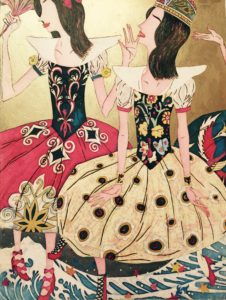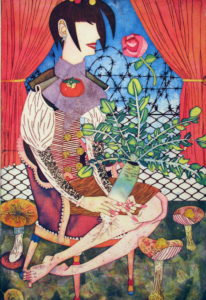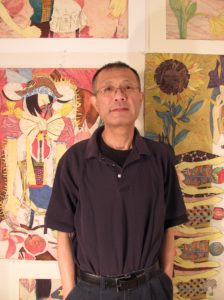Written by Special Contributor, Artist Yuji Hiratsuka

Odori
2016, Intaglio, Chine Collé, and Hand-colored
The figures are dressed western style and have tiaras on their heads.
The bottom of the image has Hokusai ukiyo-e style waves.
I was raised in Japan among a mixture of eastern and western influences. For example, Japanese gardens are cultivated high atop thirty-story Western skyscrapers and people dine at a McDonald’s fast food restaurant or sip a cup of coffee at Starbucks while watching Sumo wrestling. Japan is a land of contrasts. On the surface it might appear that the culture of Japan has taken on thoroughly American and European characteristics, but behind this Western façade, Japan’s ancient and traditional philosophies have survived.
In my work, I explore this co-existence of eastern and western influences. My images bear a slight resemblance to traditional Japanese Ukiyo-e prints (which were frequently decorative, brightly-colored and featured highly-stylized exaggerated and distorted figures) while also expressing contemporary aspects of the western world.

Queen Aggie Daikon
2013, Intaglio
The figure sits on an antique Victorian style chair. She’s holding typical Asian veggie: daikon radish. Also her chest/neck accessory is Persimmon (Asian fruit!).
Although my artwork is mainly considered representational, I deal with more metaphorical aspects rather than realistic physical evidence. The human body along with other elements – fruits, vegetables, furniture, animals, etc. – have been my most recent focus. The enigmatic figures I draw are reflections of the human conditions that people often find themselves in their daily lives: wryness, satire, whimsy, irony, paradox or mismatch. My figures also employ a state of motion or movement suggesting an actor/actress who narrates a story in a play.
Most of my work is created by the intaglio printmaking process. This involves etching, drypoint, softground and roulette on a copper plate. I use a four-color printing process (black, yellow, red and blue in order) on a thin Japanese Kozo (Mulberry) paper. As in the French use of the technique of “Chine Collé,” I apply glue to the back of the completed work and pass it through the press with a heavier rag paper beneath.
The small transitions in my work from time to time are based on the unpredictable texture that is printed from the etched surface of the copper plate. My prints explore the complex relationship of paper, ink and etched plates to describe my thoughts, as well as the relationship which occurs between figures and space to express human experiences. I try to always investigate the maximum potential available to me as a printmaker to bridge eastern and western expressions.

Artist Bio: Yuji Hiratsuka was born in Osaka, Japan. He has a B.S. in Art Education from Tokyo Gakugei University and degrees in printmaking from New Mexico State University (MA) and Indiana University (MFA). He currently is a professor of printmaking at Oregon State University.
Hiratsuka has received numerous international awards. Since 2010 he has had 13 solo shows in the US, as well as in Korea, Canada and Northern Ireland. Some of the public collections that include Hiratsuka’s art are The British Museum, Tokyo Central Museum, Panstwowe Museum in Poland, The House of Humor and Satire in Bulgaria, Cincinnati Art Museum, Cleveland Art Museum, Portland Art Museum, New York Public Library, The Library of Congress and The Smithsonian’s Museum of Asian Art.
See other images of his artwork here.
